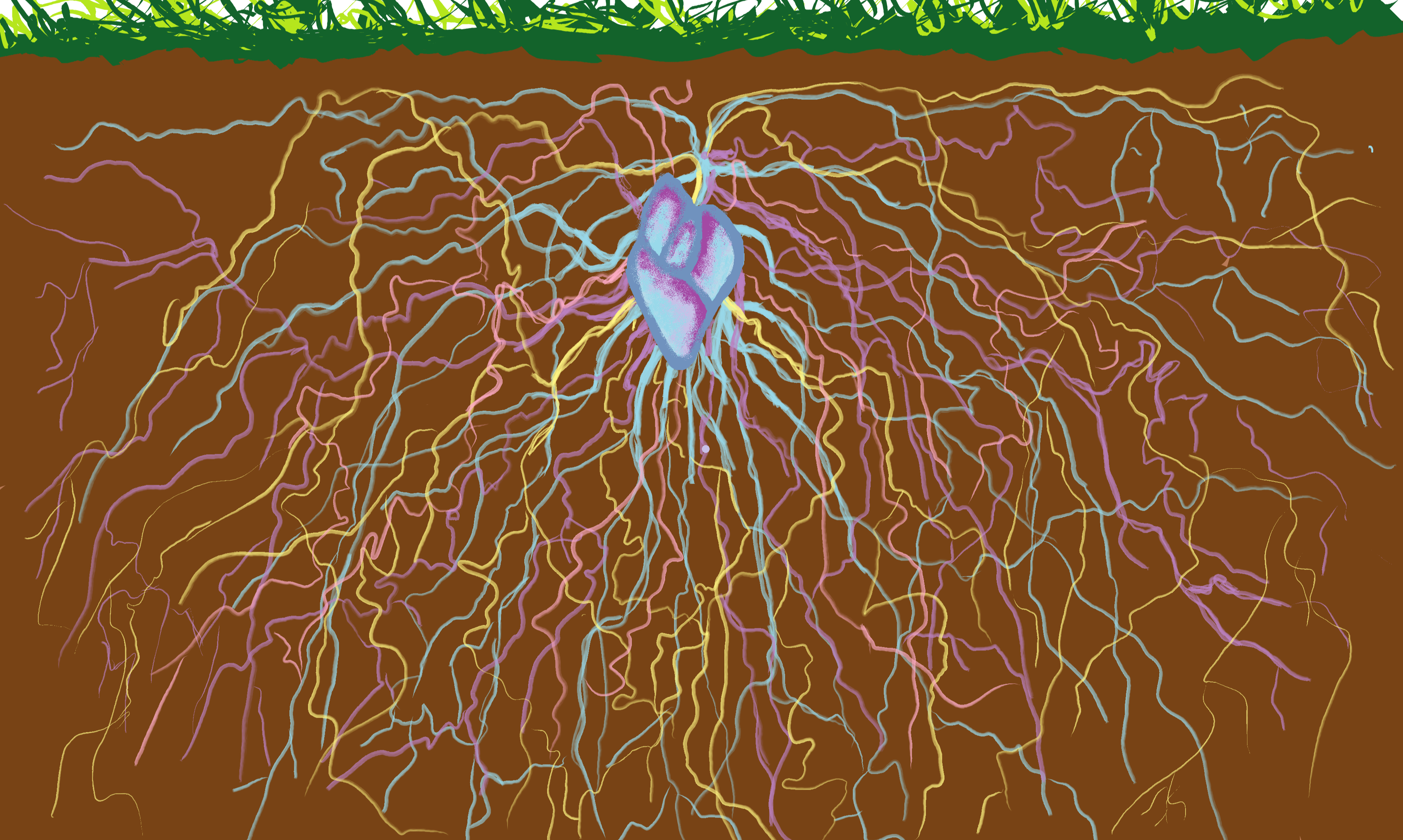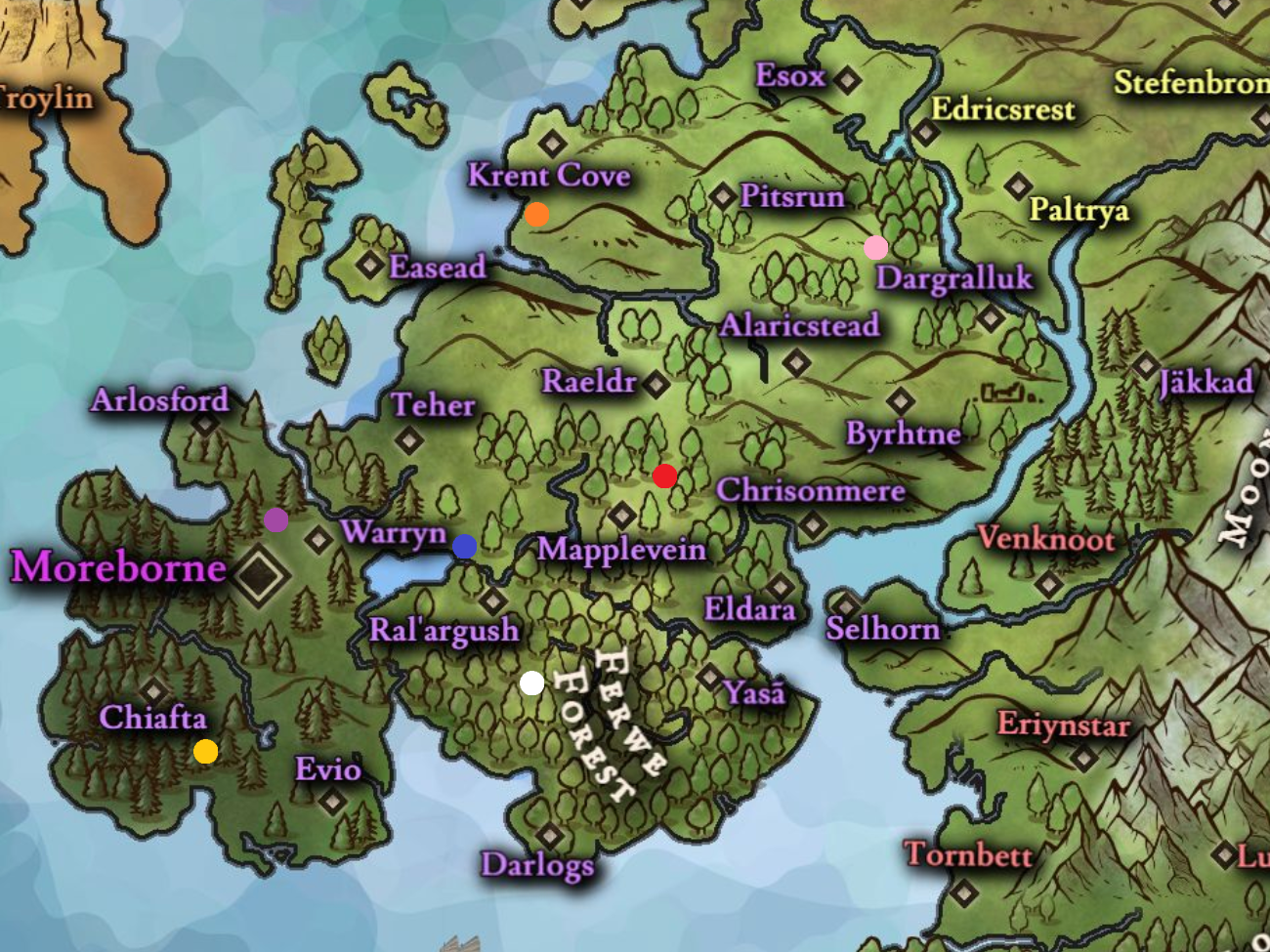The Elardail and the Elderbark Stew
In the fertile kingdom of
Del Yerlusta stand seven silent giants, older than any living realm:
The Elardail. These immense trees rise far above the canopy, the tallest and thickest beings in all of Rhycullun, perhaps even in the entire world of Eluvemar itself. To the people of Del Yerlusta, they are not merely trees but ancient sentinels, entwined with the kingdom’s magic, faith, and survival.
No surviving scroll speaks of the Elardail’s existence on any of the other continents before the
Great Separation, leaving their origins shrouded in as much mystery as their purpose. It is said that these trees were seeded in places where the gods once pressed their feet deepest into the earth, and that each tree’s silent song resonates with the hidden rivers of magic known now as the leylines.
Long ago, in the age after
the Silent Voice struck down
Silas and the gods withdrew from mortal sight, Del Yerlusta’s lands were left trembling, torn between flame and flood. In those early days, the people starved beneath blackened skies, and even priests could not coax life from the frozen soil. Hope seemed to slip away like water between fingers. In desperation, the people gathered beneath the oldest of the Elardail, raising prayers, songs, and offerings of blood and sacred herbs.
After a time, moved by mortal devotion, the tree began to weep
Eithilsil, a sap of shimmering silver, glinting like moonlight and soon renowned for its power to heal the sick and soothe those near death. The sap did not simply spill down the trunk. It coursed slowly through hidden channels within the tree’s living wood, emerging through slender fissures in the bark to trickle delicately along the surface. Only when Eithilsil flows downward and pooled gently in the hollow bowls formed by the Elardail’s massive roots could it be gathered safely. To harvest it at any other time, or scrape it directly from the trunk, was said to invite curses and doom.
When the next dawn arrived, curls of bark, glowing a pale, storm-swept blue, began to loosen and fall, filling the glade with a fragrance of sweet spice and iron.
From this fallen bark was born the first
Elderbark Stew. The villagers gently simmered it with their last bits of meat, vegetables and dark red Elvish wine. Those who tasted the dish spoke of warmth coursing through their veins, wounds closing as if they were sewed together by invisible fingers, and visions of glowing paths beneath the earth; where the forever moving leylines flowed like rivers of living light. Thus,
the legend of the Elardail became forever bound to the story of Del Yerlusta, and the forest’s bounty was tied to the memory of salvation.
Life Cycle and Harvest of The Elardail
The Elardail seems to guard secrets deeper than even Del Yerlusta’s most ancient songs can capture. Each tree lives for centuries, sometimes as long as nine hundred to a thousand years, before producing a single seed known as
The Heart. Unlike ordinary seeds that fall to the forest floor, the Heart travels downward through the inside of the tree’s massive trunk, moving through hidden channels of living wood and spirit, and finally passing into the deep earth below. Once there, it seeks out a secret place of power where it can anchor new roots. This subterranean journey can last a century, as the Heart silently tests the soil, searching for the perfect cradle from which a new giant might rise. It is only after the Heart has begun this hidden descent that the parent tree begins to die, marking the end of its long vigil over the forest.
The death of an Elardail is never sudden but comes as a slow, mournful fading. The tree begins to shed its blue bark in loose spirals, a silent signal to the people of Del Yerlusta that the Heart has departed on its journey into the depths of the earth. Only during this natural shedding can the bark be gathered safely, for to strip it prematurely is to invite ruin. Should anyone dare to take the bark before the tree offers it freely, its vibrant blue drains away, leaving it black and brittle like charred bone. Worse still, a dreadful curse is said to fall upon the thief, sapping life and warping the mind until the victim’s spirit becomes bound to the forest floor, lost forever among the roots. Even when the bark falls of its own accord, not all of it will be shed before the tree breathes its last, leaving any harvest uncertain and small. This unpredictability is one of many reasons why the blue bark is so exceedingly rare.
When harvested with patience and reverence, the blue bark can become the heart of the Elderbark Stew, or be stored away for years to come. For the Elderbark Stew, the bark is shaved into delicate ribbons and gently cooked with rich red Elvish wine and broth for three days, before the succulence of forest game and vegetables is added. Those fortunate enough to taste this dish claim it carries a bright mineral freshness, a floral sweetness edged with spice, and a subtle warmth reminiscent of sunlit stone. Beyond its remarkable flavour, the Elderbark Stew is believed to possess true magic. A single taste is said to mend minor wounds, conjure vivid dreams touched by Galinda, Mother of Creation, or grant fleeting glimpses of hidden leylines.
Current Age
In the present age, seven Elardail stand in Del Yerlusta’s quiet groves. Each differs not only in age and history but also in the brilliant, unnatural colour of its leaves, a trait that has fascinated generations. Six bear names that are woven in the flowing syllables of the Elvish tongue, while one carries a name gifted by the dwarves who found it clinging to sheer stone cliffs above a roaring river gorge. The seven trees are known as
Luinlothar, whose leaves glow the purest blue;
Morlothiel, cloaked in royal purple;
Gulthilwen, crowned in luminous pink;
Mallenoriel, whose golden leaves shine like Jaune's sunlight;
Carnelion, blazing with fierce red;
Nimlothar, adorned in gleaming white; and the dwarven
Karnhulm, whose leaves made of blaze molten orange.
These ancient trees are guarded fiercely by druids, forest keepers, and secretive orders who understand how vital they are to the kingdom’s survival. Many fear that should even one of these ancient beings fall, the delicate balance sustaining Del Yerlusta’s fertile lands might falter, sending ripples of ruin far beyond its borders. For most, the Elderbark Stew has become a legend, spoken of far more often than it is ever tasted, surrounded by reverence and a quiet undercurrent of dread.
The Myth & Mystery Continues
Among the people of Del Yerlusta, the myth endures that should a famine rise again, the Elardail might choose to shed their gift once more, saving the kingdom from ruin. Some elders claim that the trees can hear the weeping of starving children carried on the wind, and that their roots twitch beneath the earth when the kingdom suffers. It is said that the colour of their leaves deepens when they sense mortal sorrow, and that at the hour of greatest need, a single silver drop of Eithilsil might fall without warning, a sign that the trees have begun to stir in compassion.
Stories speak of a hidden pact forged in the age before the sundering, when
Galinda, Mother of Creation, whispered to the first seedlings of the Elardail, binding them to watch over mortal lands as guardians and silent witnesses. Each tree, it is said, holds a fragment of her dream. Should that dream ever fully awaken, the Seven Trees might blossom all at once in dazzling light, transforming the leyline beneath Del Yerlusta into a river of pure magic that could heal the kingdom, or drown it in divine power beyond mortal reckoning.
Just as the Elardail might save the realm, so too can they turn away. In hushed tones, folk whisper that the trees remember greed and blood spilled beneath their boughs. Should mortals try to steal what the Elardail have not freely given, even the gods may turn their faces away. Some say the trees could grow silent forever, their leaves fading like dying stars, severing the flow of magic through the leyline. Others warn that the trees might become wrathful, twisting their roots through villages and forests alike, reclaiming all that was stolen, and more….
Thus, the story of the Elardail and the Elderbark Stew endures, not merely as a tale of rare food, but as a testament to the fragile covenant between mortals and the living world, and to the truth that sometimes, even in silence, the gods still whisper through the rustle of leaves and the winding of hidden roots.










I loved this article, its a wonderful bit of story telling, the mythweaving of it is fantastic. The heart concept was perhaps my favorite bit. The stew itself sounds both delicious and mystical, and I like how you do not merely outline powers, but offer tidbits, never really suggesting that there is a quantified or known 'ceiling' to what this can do. That adds to the mythos of it, the mysticism if you will.